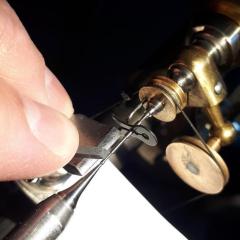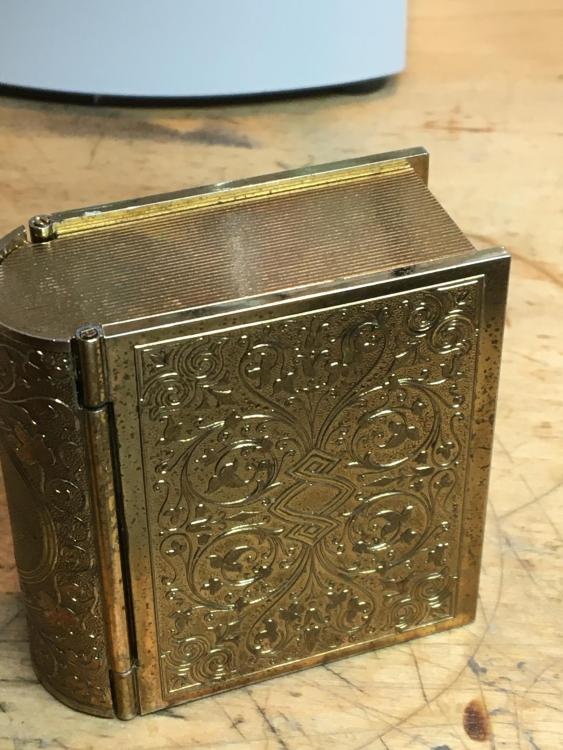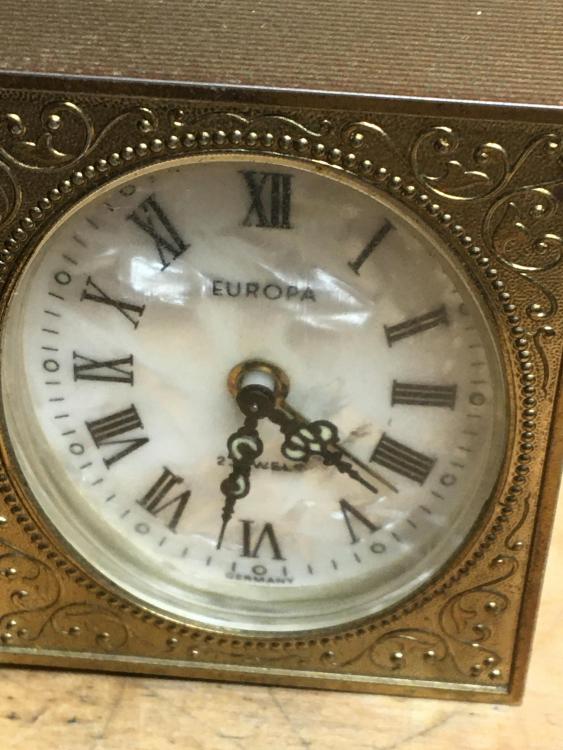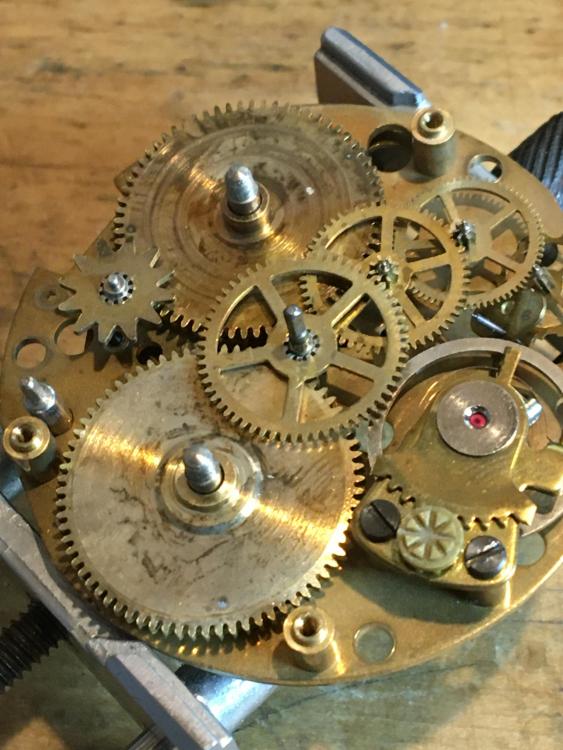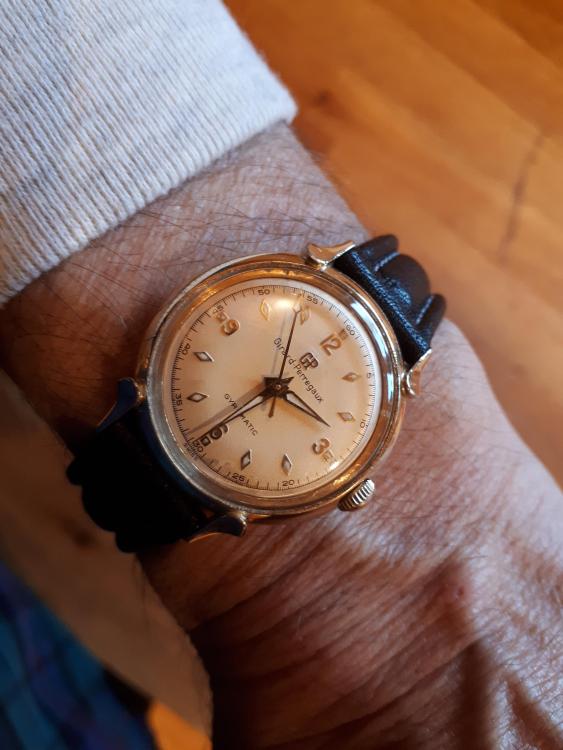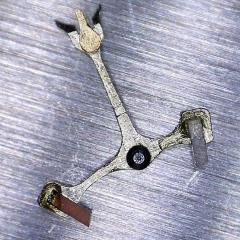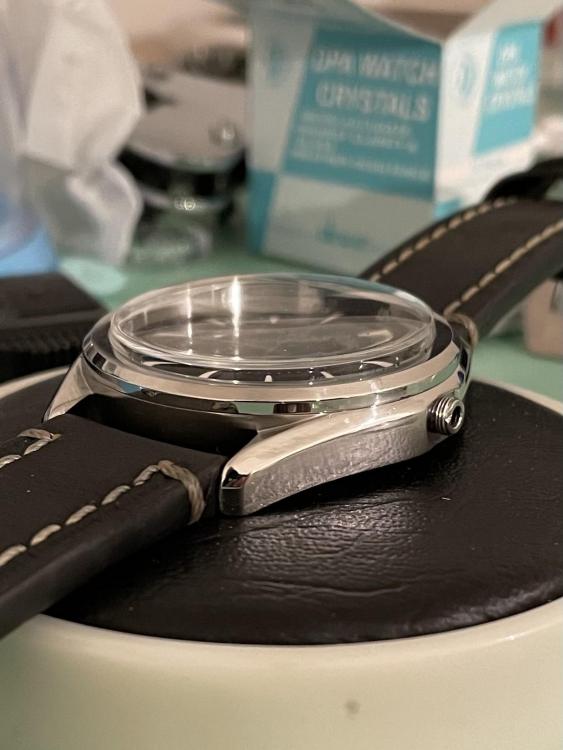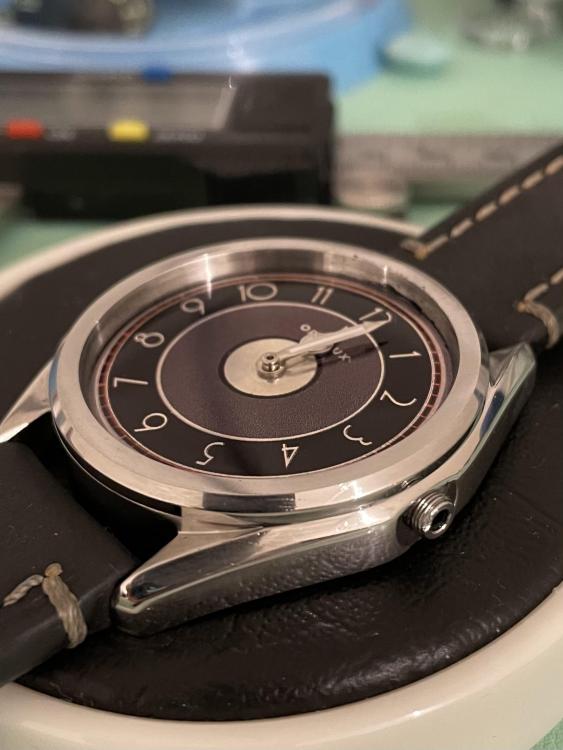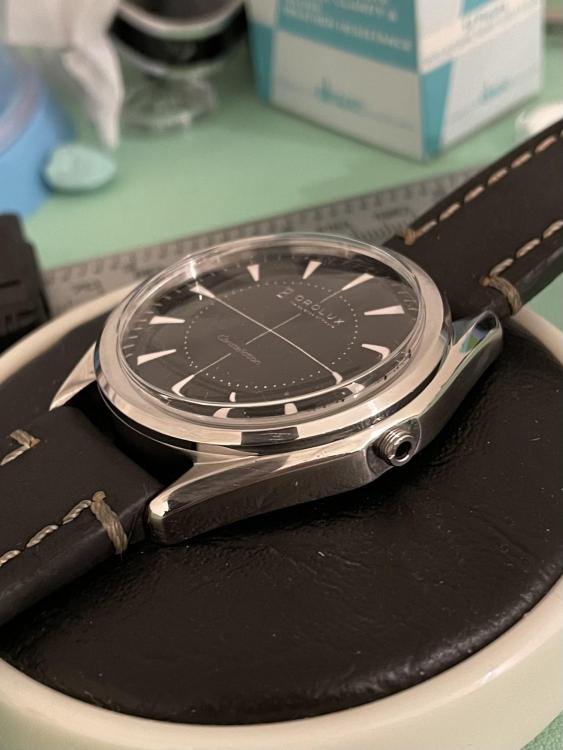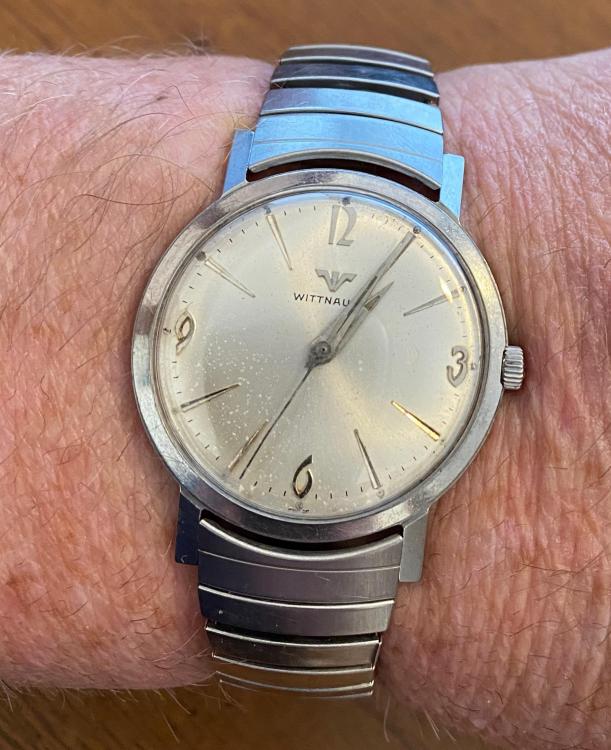Leaderboard
Popular Content
Showing content with the highest reputation on 11/12/21 in all areas
-
2 points
-
I've been in factory workshops where Rodico was banned. I'm sure because of abuse from lazy watchmakers. In one I was checking kits of components for a client and asked for some ,"no, we don't use that here...", asked again if he was sure they didn't have some (head watchmaker there), he whispered "ok, but don't let the others see!". Hahaha.2 points
-
Here is a strange one that arrived this week. It is a German book style alarm clock. It was not working due to dirt / grime and the lower bushing that holds the balance had been moved too low. Yes the owner had fiddled!!! ( notice the smeared dial ) But it does have great sentimental value so I agreed to try and fix.It is now running on test. See below some pics in no particular order.2 points
-
2 points
-
A couple of notes regarding cracked jewels? As long as it's a hairline crack that doesn't seem to be really noticeable on the bearing surface in other words is more like an internal fracture flaw then it's acceptable and leave it alone. A lot of people use to modern perfect jewels freak out at natural stones and their internal flaws. The problem is you can't replace all the jewels in the watch even though I've seen this come up on discussion groups. Balance jewels that's different usually have a staff breaks you want to look very carefully at those nice tiny round hole becomes usually not round and lots of sharp edges. The other reason I bring up to jewels are there's another book that's even harder to find which is the Swartchild's American Balance Jewel book. So I just list all the different sizes of the jewels used. Another really nice pocket watch references this Swigart American Watch Movements I see it's available at Amazon at a really interesting price. I'm giving you the link just because it's so humorous and I see they have used copies at equally humorous prices https://www.amazon.com/Illustrated-Manual-American-Watch-Movements/dp/B001MCD7FU Here's another source at a much more reasonable price https://www.jewelerssupplies.com/illustrated-manual-of-american-watch-movements-620.020.html Here's somebody online that will sell you a PDF I haven't looked on eBay lately but usually somebody on eBay is selling it as a PDF. Then the reason you're not finding it available free using the assumption that all PDFs are free no notice there's at copyright disclaimer on this page. http://www.watchmakingbooks.com/ebooks---pdf-formatted-books.php#!/Swigart-Illustrated-Manual-of-American-Watch-Movements-PDF-eBook/p/19103713 Then the best place looks like right now eBay. Then as typically on eBay you are look at all the prices some were interesting not as interesting as the Amazon price. Somebody even has an auction love three of the physical books you really don't need 31 will do. Then even have an electronic version which I put at the link below with some bonus stuff on their disc https://www.ebay.com/itm/2749222940311 point
-
1 point
-
1 point
-
For a good pre-clean, brush the parts ( while still wet) using a bit of powdered detergent. In case part have dried now, resoak in CocaCola before brushing. I give the parts couple of cleans in unltrasonic after the pre clean.1 point
-
And the winner (so far) is................. a 48 hour soak in CocaCola. This seems to have dissolved the corrosion around the screw just enough to get it to turn. I was beginning to think it would never come off. The final test, of course, will be if the movement works after reassembly. Thanks all.1 point
-
Going back to your original question about the two dial washers, I wouldn't be concerned. It is a valid method of increasing the distance over which a disc spring acts, without increasing the rate, or taking up play in other words. The orientation is the key. The other way round you get the same deflection as a single spring, but double the rate.1 point
-
1 point
-
Hi Unitas 497 attached to be able yo make a comparison with JohnR725's Bulova 16 sheet Unitas 285, 497, 498, 6500 (1).pdf1 point
-
Thanks for the info. Here's hoping it is all solvable as I want to keep it for myself.1 point
-
The term to search for is "Latch Spring". (The one that pushes the cover open is the "Lift Spring"). On such hunter cases, they are often two ends of the same hemispherical spring. ~ IF your spring is broken, here is what you will need to do: you will need to withdraw the movement to examine the spring in the case, when the watch arrives, to determine if you have two separate springs or just one. NOTE: they are often pinned into the case along the rim. To remove the spring, you must remove the pin, and to remove the pin you will need stiff wire or rod of the same diameter or smaller to use as a sort of punch. As to finding a replacement spring, that will be the hard part. You can try Ofrie watch, or here: https://www.daveswatchparts.com/. There are also people selling assortments in lots on Ebay and Etsy. That was what I did, since I work on antiques rather often. I have a bunch of springs now. They were cheap. I often find the size I need, or can use one that needs very little alteration. ~ IF a former owner was an oblivious or careless jerk, and used to snap the cover shut, to the point that the cover's lip is so worn down that the latch no longer has enough metal to grip, then you have a much different problem. If you wish to keep that case, the lip will need to be peened and stretched outward a bit. I had to build a jig to help me do this. The cover will need to be removed first, as well. Alternately, re-casing is an option, but that has difficulties too. You need the correct size (diameter) and correct thickness, and you must be prepared to alter the stem, and perhaps change crowns if yours is too big or small. If it is a lever-set, you must be prepared to make adjustments to the lever slot in the case, and the one in the bezel. You may find there are other watch sites which have vintage parts. It never hurts to check around. What you learn when you examine the watch will determine the path you take.1 point
-
Looking at your pictures again one of things that bothers me is look where the stud holder is? Typically get find the regulator in that position and the stud holder should be moved back considerably. But in need to look at whether the watch visually is in beat and put that where it's supposed to be it may be somebody is bumped that it may be grossly out of beat or it may just be fine. The understand what I mean by this look at the link for the 694 I have above and you'll notice that the stud is in a different location1 point
-
http://cgi.julesborel.com/cgi-bin/matcgi2?ref=BUL_16AB Looks like your research be doing better than the material house did? Found your movement above parts list including the Canon pinion height. Normally if you click on a part it give you everything Including a cross references to, and they don't seem to think cross to anything? Although it Does look a lot like the 497 in the picture below except the balance wheel jewels? http://www.ranfft.de/cgi-bin/bidfun-db.cgi?10&ranfft&0&2uswk&Unitas_497 Then I did find You a parts list. Bulova_Bulova 16AB.pdf1 point
-
C11BG movement is in house Certina made. I am not sure if its based on AS1201.1 point
-
It is the first coil, it is just over the second coil as it takes its first turn.1 point
-
It was nice that you did clarify because as long as you're happy with your balance staff and have zero intention of ever changing it then is taking set is probably of no use to you. But if you work on vintage pocket watches you do tend to run into broken staffs. Or if you work on modern watches I know of people work on Rolex watches and they change staffs all day long just because they have to be perfect for timing requirements. So apparently they never change a staff because it's broken only for timing Reasons. Seems like on a watch repair discussion group you wouldn't be paying a watchmaker you would learn how to do it yourself? So here's the problem on American pocket watches or basically anything vintage. They were not mass-produced even though they were. As a rather confusing sentence isn't it? Basically the escapement's are all adjusted to the particular components in the watch. Like American pocket watches all the bridge parts are serial numbered you can't take a bridge from one watch and put it on another because the serial numbers don't match and probably needed to the holes. If you swap a complete balance wheel your pivots sizes may not be the same in other words you could need to be too loose or too tight somebody will have to adjust that. Possibly because the escapement's are all adjusted somebody will have to adjust the escapement. But if you're doing a vintage watch that is standard operating procedure and that shouldn't be an issue. Which is usually why always recommend trying to keep as many of the original components as you can for your vintage watch Here are two other references I have first one somebody selling it on eBay which is nice. This is obscure book that most people I don't even think new that even existed. The second book I got it as a PDF off of eBay but it doesn't seem to be there anymore probably because people PDF thing copyrighted material get in trouble. So I'm giving you a reference to the Amazon where you can see its actual book is probably out there someplace. This is the one where I found the measurements because what they did is they went through and measured a huge assortment of staffs and arrange the book by sizes. Then in the back they have the various reference material including the drawings. Swartchild's American Balance Staffs https://www.ebay.com/itm/162769575312 American Watch Balance Staff Interchangeability https://www.amazon.com/American-pocket-wrist-balance-interchangeability/dp/09139025271 point
-
Have a look at Ranff.de unitas 9647 for further details and information.1 point
-
You can service and get the watch running before ordering these parts, you might need others.1 point
-
Hi John, my only hesitation with that is that I typically work on older watches, where NOS parts are not necessarily the easiest to come by, which would limit the usefulness of a staking set and not justify the cost. Granted there are vintage sets you can get under $200, but I typically only buy watches that have good balances to begin with. This one was a fluke, if I had known it had a broken balance I wouldn't have bought it. Not opposed to the idea though.1 point
-
Whittenaur C11BG sheet is elusive but fid attached the AS1201 parts sheet so you may make a comparison with your movement. chees 2450_AS 1200,1201.pdf1 point
-
It dawned on my while looking at these beat numbers that I could test the accuracy of my B200 by simply using an accurate quartz watch! While you do not get the 5 (e.g.) beats per second, you do get one. It will generate a vertical line on all settings. I did this and it appears that my B200 is dead on.1 point
-
1 point
-
I see it isn't standing on a carpet which is a good thing. My advice is don't put it on a carpet, if you do make sure it isn't near were anyone walks as it can up set the balance of the case and the clock could stop. If you do so screw the case to the wall so it can't move.1 point
-
Thats one good clock for $5 dollars, worth the $25 dollar collection any day. Suspension even an assortment bag costs £10 its still a bargin . well done and good luck with the clock dont forget the pictures.1 point
-
Centre wheel has been found to have 12 pinion leaves each one transitioning every 5 minutes. Barrel has been found to be tilting due to worn bottom arbor hole. The tilting causes the meshing of the teeth to become tight (dropping amplitude) as the barrel tooth transits across the pinion leaf. I can see wear points on the brass barrel teeth indicating that. I am going to close the barrel arbor hole with a rounded punch to try and get the barrel to run flatter. Will post progress soon.1 point
-
1 point
-
Yeah, but London is a proper city. Munich is called the "Millionendorf", a village with a million inhabitants, which seems about the Goldilocks size. London, like Berlin, has much more vitality, but I'd rather live here. I still miss the UK (though less and less in the past few years). I spend my New Year's Eve cooking and watching the Hootenanny on the BBC!1 point

